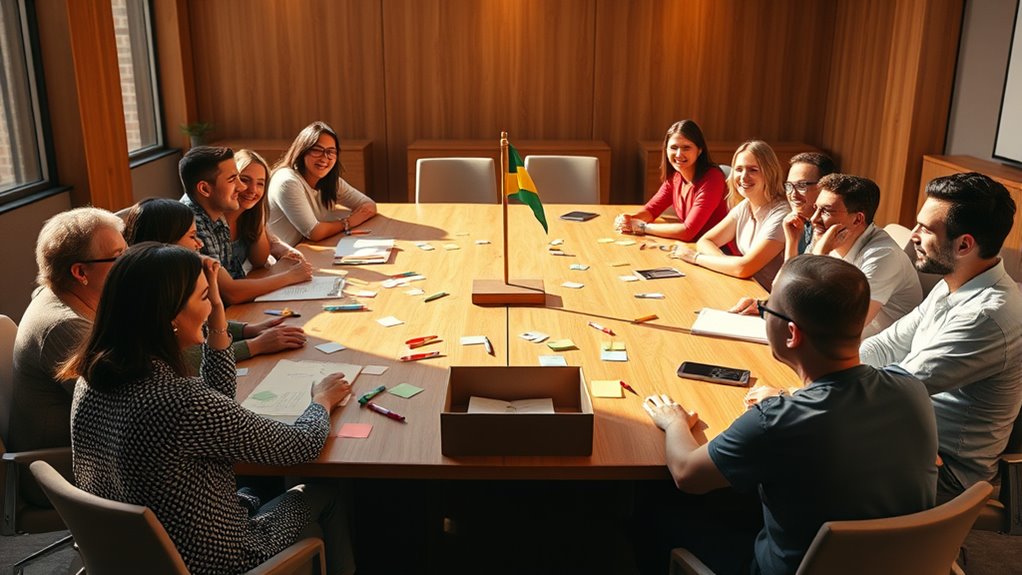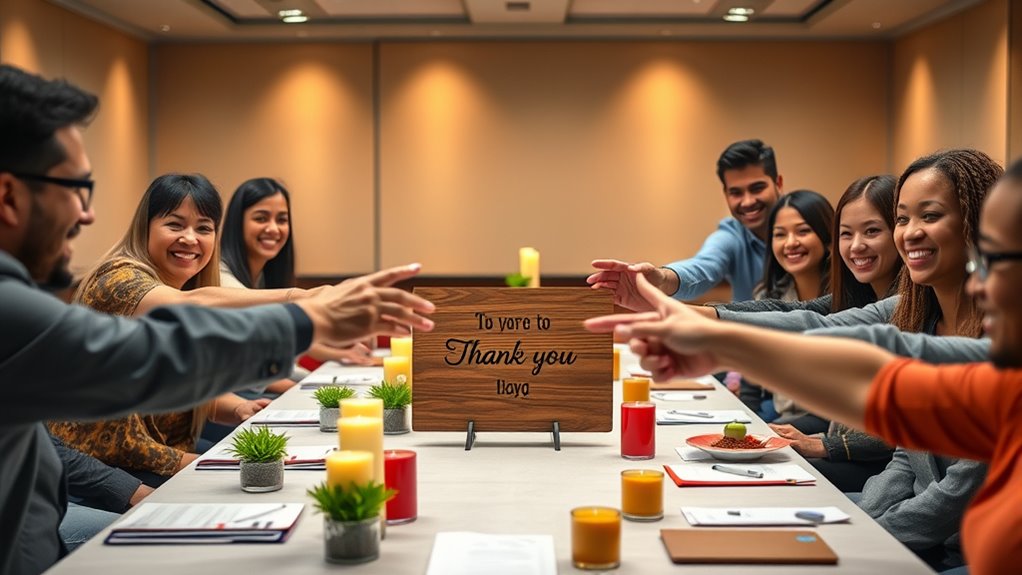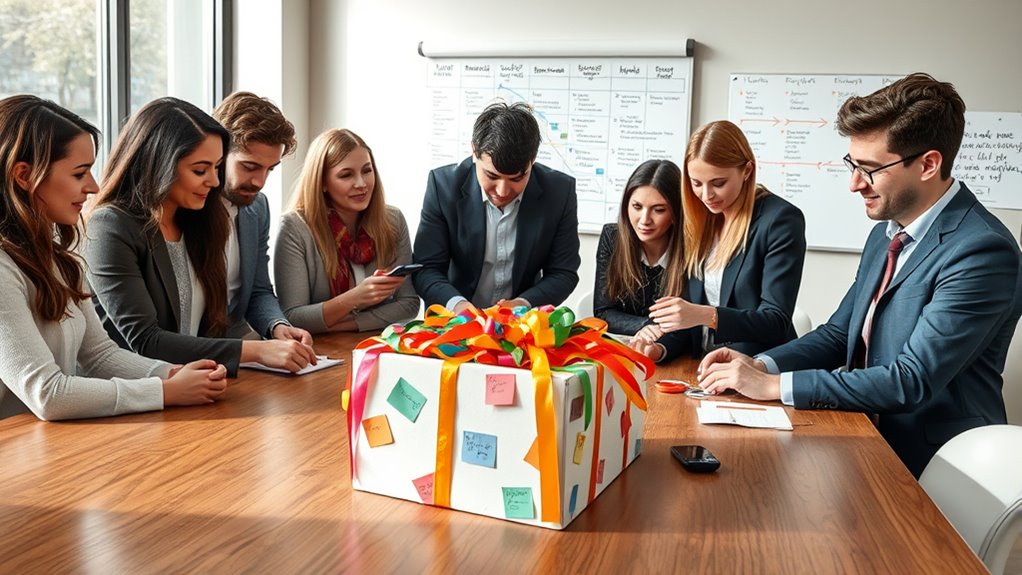To design effective closure rituals, start by clearly defining your goals, like celebrating achievements or reflecting on lessons. Engage your team in planning activities such as storytelling, symbolic gestures, or recognition ceremonies that highlight milestones and foster gratitude. Incorporate meaningful activities that honor your shared culture and values while promoting emotional release. Focus on creating memorable moments that reinforce team cohesion and success—keeping these elements in mind will help craft a lasting and impactful closure experience.
Key Takeaways
- Clearly define goals and expectations for the closure ritual, ensuring alignment with project outcomes and stakeholder involvement.
- Incorporate meaningful activities like storytelling, symbolic gestures, or token exchanges to foster emotional and cultural significance.
- Celebrate milestones and achievements through recognition, sharing success stories, and acknowledging individual and team contributions.
- Facilitate reflection on lessons learned and address unresolved issues to promote growth and emotional closure.
- Use sound and visual design elements to enhance emotional impact and create a memorable, cohesive experience.
Recognizing the Importance of Closure Rituals

Recognizing the importance of closure rituals is essential because they mark the end of a project and help team members shift smoothly. These rituals facilitate emotional release, allowing everyone to process feelings of accomplishment or disappointment. They also carry cultural significance, honoring shared traditions and values that give the team a sense of identity and unity. When you intentionally create a meaningful closure, you provide a space for reflection and acknowledgment, which can reduce stress and foster a positive mindset moving forward. Ignoring this phase risks leaving unresolved emotions and lingering tension. By understanding the emotional and cultural importance of closure rituals, you guarantee your team transitions effectively, celebrating successes and learning from challenges in a respectful, supportive environment. Additionally, aligning with emotional vibration can enhance the overall effectiveness of the closure process by promoting a positive and receptive atmosphere.
Setting Clear Objectives for the Ritual

To create an effective closure ritual, you need to clearly define its goals and guarantee they match the project’s overall outcomes. Communicate these expectations openly with your team so everyone understands the purpose. When goals are aligned and clear, the ritual becomes a meaningful and memorable conclusion. Incorporating clear objectives helps ensure the process is structured and impactful.
Define Ritual Goals
Setting clear objectives for your ritual guarantees it effectively marks the project’s conclusion and meets your team’s needs. By defining specific goals, you ensure the ritual fosters emotional closure and emphasizes cultural significance. Think about what you want everyone to feel and remember, whether it’s gratitude, reflection, or celebration. Clear goals also help you choose meaningful activities that resonate with your team’s values and traditions. Imagine a moment where team members share stories, exchange tokens, or perform symbolic gestures—each aligned with your objectives. Establishing these aims keeps everyone focused and intentional during the ritual, creating a lasting impression that honors the project’s journey. Incorporating sound design techniques can enhance the emotional impact of the ritual by creating a memorable atmosphere. Ultimately, well-defined goals turn a simple act into a powerful closure experience.
Align With Project Outcomes
Aligning your ritual with the project’s outcomes guarantees that it authentically reflects the work completed and the goals achieved. To do this, review your project planning carefully, identifying key deliverables and milestones. Focus on how the project met its objectives and what stakeholders expected. Engaging stakeholders throughout this process helps guarantee the ritual resonates with everyone involved, reinforcing their sense of accomplishment. Clear objectives for the ritual should highlight specific successes and lessons learned. By tying the ritual directly to these outcomes, you create a meaningful closure that celebrates progress and clarifies achievements. Understanding the importance of appliance maintenance plans can also serve as a metaphor for ongoing reflection and upkeep of project results. This alignment ensures the ritual is relevant, focused, and truly representative of the project’s impact.
Communicate Expectations Clearly
When planning a ritual of closure, clearly communicating your expectations guarantees everyone understands its purpose and significance. Use expectation clarification to ensure all team members know what the ritual aims to achieve. Employ effective communication strategies, like open dialogues and visual aids, to reinforce these goals. Visualize the scene:
- A shared agenda guiding the discussion
- Clear statements about the ritual’s intent
- Visual cues highlighting key moments
- Feedback loops confirming understanding
- A summary emphasizing intended outcomes
Being aware of the importance of color accuracy in creating a meaningful experience can also help set realistic expectations for the visual aspects of the ritual.
Involving the Entire Team in Planning

Involving the entire team in planning the closure process guarantees that everyone feels invested and responsible for a successful outcome. You should facilitate team brainstorming sessions where everyone can share insights and ideas. This collaborative planning approach ensures diverse perspectives are considered, making the process more detailed and engaging. When team members contribute to shaping the closure activities, they develop a sense of ownership and commitment. Encourage open dialogue, listen actively, and incorporate different viewpoints. This collective effort helps identify potential challenges early and fosters a shared understanding of what needs to be accomplished. Additionally, understanding the importance of team engagement can significantly enhance the effectiveness of project closure. By involving everyone in planning, you create a more cohesive and motivated team, setting a strong foundation for a meaningful and effective project closure.
Reflecting on Achievements and Challenges

Reflecting on achievements and challenges allows your team to gain valuable insights from the project experience. It creates feedback loops that foster continuous improvement and emotional closure, helping everyone process successes and setbacks. During this reflection, you might envision:
- Celebrating milestones reached together
- Identifying obstacles that tested your resilience
- Analyzing what strategies worked best
- Recognizing individual contributions
- Addressing unresolved issues for closure
- Considering how successful co-parenting tips can inform teamwork and collaboration in future projects.
This process encourages honest dialogue, deepening understanding and trust within the team. By consciously revisiting both triumphs and struggles, you provide space for emotional closure, making it easier to move forward. Ultimately, reflection solidifies lessons learned, preparing your team for future projects with clarity and confidence.
Celebrating Successes and Milestones

Celebrating successes and milestones helps you acknowledge your team’s hard work and dedication. By recognizing achievements, highlighting key moments, and sharing success stories, you reinforce a sense of pride and motivation. These celebrations create meaningful closure that inspires future efforts. Incorporating performance metrics and feedback can further enhance the impact of these acknowledgments.
Recognize Team Achievements
Recognizing team achievements is a vital step in bringing a project to a meaningful close. It’s about acknowledging everyone’s efforts and showing appreciation through genuine team recognition and motivational rewards. This fosters a sense of accomplishment and motivates future collaboration. Picture the team gathered in a celebratory setting, smiles shared, and voices excited. Imagine awards being handed out, personalized notes of thanks, and a visible display of project successes. Consider a spotlight session highlighting individual contributions, a toast celebrating collective effort, or a certificate ceremony. These moments create vivid memories that reinforce the value of everyone’s work, boost morale, and set a positive tone for future projects. Recognizing achievements ensures your team feels valued, appreciated, and motivated to continue excelling.
Highlight Key Milestones
Highlighting key milestones is essential for marking the progress your team has made and reinforcing a sense of achievement. By engaging in milestone mapping, you identify significant points in the project timeline that demonstrate your team’s efforts and advancements. Once these milestones are clear, you can implement celebration strategies to acknowledge these successes effectively. Celebrations could range from informal acknowledgments to formal events, depending on the milestone’s importance. Recognizing milestones not only boosts morale but also provides tangible evidence of progress, motivating your team to stay committed. Additionally, understanding the mechanics of pinball machines can serve as a metaphor for how different components of a project work together to achieve success. Keeping the focus on these key achievements helps everyone see how their contributions drive the project forward, fostering a culture of shared success and continuous motivation at the project’s conclusion.
Share Success Stories
Sharing success stories builds on the milestones you’ve identified by putting real faces and experiences behind the achievements. When you highlight team efforts and individual contributions, you foster team bonding and provide emotional closure. These stories create vivid imagery and inspire others to see their impact. Imagine:
- A team member receiving heartfelt praise during a celebration
- A project challenge turned into a valuable lesson
- Colleagues sharing moments of pride and relief
- Memories of late nights and shared laughter
- The collective sense of accomplishment echoing in the room
Including recognition benefits and celebrating successes helps reinforce positive behaviors and motivates continued excellence.
Documenting Lessons Learned for Future Projects

To guarantee continuous improvement, documenting lessons learned at the end of a project is essential. Conduct a project retrospective to reflect on what went well and what didn’t. During this session, gather insights from team members and stakeholders to identify key lessons. Ensure thorough lessons documentation by recording specific examples, challenges faced, and strategies that worked. This clear record helps future projects avoid repeating mistakes and builds on successes. Share the lessons learned with relevant teams and incorporate them into your organization’s best practices. Doing so not only promotes continuous growth but also fosters a culture of openness and learning. By systematically capturing and applying these insights, you set your team up for even greater success in upcoming initiatives.
Creating Opportunities for Gratitude and Recognition

Have you considered how recognizing team members’ efforts can boost morale and foster a positive project culture? Creating opportunities for gratitude and recognition through gratitude expressions and recognition ceremonies reinforces appreciation. These moments highlight individual contributions and encourage a sense of achievement. Visualize a recognition ceremony where team members smile as their efforts are acknowledged. Imagine heartfelt gratitude expressions shared during a closing meeting, strengthening bonds. Think of personalized thank-you notes that leave lasting impressions. Picture a wall of appreciation displaying team achievements. Envision a celebratory atmosphere where everyone feels valued and inspired to carry forward their positive momentum. Incorporating these rituals ensures acknowledgment becomes an integral part of project closure, leaving team members motivated, appreciated, and connected.
Facilitating Transition and Next Steps

Building on the sense of achievement from recognition, guiding your team smoothly into the next phase guarantees momentum is maintained. Clear handover processes are essential for a seamless progression, ensuring responsibilities are communicated and understood. Encourage emotional detachment from the project’s daily grind, helping team members shift focus and avoid lingering attachment. To facilitate this, consider the following:
| Step | Action | Outcome |
|---|---|---|
| Document Handover | Prepare thorough documentation | Smooth transfer of knowledge |
| Assign Responsibilities | Clearly define roles for next steps | Clarity and accountability |
| Emotional Closure | Acknowledge feelings, then let go | Reduced attachment, readiness to move forward |
| Feedback Session | Discuss lessons learned | Continuous improvement |
| Follow-up Plan | Set future check-ins | Maintain momentum and support |
Incorporating Personal and Team Feedback

How can you effectively incorporate personal and team feedback to foster continuous improvement? By actively listening to individual insights and observing team dynamics, you create a culture of openness. Encourage honest reflections through structured feedback sessions or anonymous surveys. Use personal insights to understand each member’s experience, while analyzing team dynamics to identify patterns or gaps. Share feedback in a constructive manner, emphasizing growth. Visualize this process as a mosaic of shared perspectives, where each piece contributes to a clearer picture of success. Remember, integrating feedback isn’t just collecting comments; it’s about creating a dialogue that drives ongoing improvement, strengthening team cohesion, and refining future projects. This approach ensures everyone feels heard and invested in continuous progress.
Sustaining Closure Practices for Ongoing Growth

To guarantee that closure practices lead to ongoing growth, you must embed reflective and evaluative routines into your project lifecycle. This ensures rituals evolve alongside your team’s needs, fostering continuous improvement. Use closure symbolism to highlight achievements and lessons learned, reinforcing their importance and encouraging ongoing commitment to growth. By maintaining rituals of reflection after each project phase, you create a culture where learning becomes embedded in your processes. Over time, these rituals evolve, adapting to new challenges and goals, keeping your team engaged and motivated. Sustaining closure practices isn’t about a one-time event but about embedding meaningful routines that promote growth, resilience, and a shared sense of accomplishment—fueling future success through consistent reflection and symbolic recognition.
Frequently Asked Questions
How Can I Tailor Closure Rituals for Different Team Sizes?
When tailoring closure rituals for different team sizes, consider how personalization impacts effectiveness. For small teams, create intimate ceremonies like personal reflections or shared meals, fostering strong bonds. For larger teams, opt for scalable activities such as group acknowledgments or virtual celebrations that include everyone. Adjust the level of personalization based on team size, ensuring each member feels valued and connected, regardless of the number involved.
What Are Common Pitfalls to Avoid During Closure Ceremonies?
While it’s tempting to overlook certain pitfalls, you should be mindful of team resistance and lack of reflection during closure ceremonies. Avoid rushing the process or forcing participation, which can heighten resistance. Make certain you create space for honest reflection, as skipping this step hampers learning. By fostering openness, you prevent the ritual from feeling superficial, helping your team truly benefit from the closure and move forward cohesively.
How Do Cultural Differences Influence Closure Rituals?
You should recognize that cultural differences greatly influence closure rituals. Cross-cultural communication helps you understand diverse traditions, ensuring respectful and meaningful ceremonies. Different cultures have unique ways of marking endings, from symbolic gestures to specific words or ceremonies. By acknowledging these variations, you create a more inclusive environment, fostering trust and understanding among team members. Embracing diverse traditions enriches your closure process, making it more impactful and culturally sensitive.
When Is the Optimal Time to Hold a Project Closure Event?
You should hold a project closure event when the timing considerations align with the team’s emotional readiness. Wait until key stakeholders feel satisfied with project outcomes and have had time to process successes and challenges. Avoid rushing the event too soon, as it might hinder genuine reflection. By choosing a moment when everyone feels prepared, you foster a meaningful closure that acknowledges efforts and sets a positive tone for future projects.
How Can Remote Teams Effectively Participate in Closure Rituals?
You can guarantee remote teams effectively participate in closure rituals by leveraging virtual presence tools like video calls, ensuring everyone feels included. Encourage team members to share their reflections and achievements, fostering emotional closure. Use breakout rooms for intimate conversations, and record sessions for those who can’t attend live. This approach helps remote participants feel connected, valued, and emotionally fulfilled, completing the project with a shared sense of accomplishment.
Conclusion
By implementing thoughtful closure rituals, you help your team celebrate achievements and reflect on lessons learned. Some might think these rituals are just formalities, but they actually foster trust and motivation. When you create meaningful moments of recognition and shift, you build a stronger, more cohesive team. So don’t skip the closure—embrace it as a crucial step that sets the stage for future success and continuous growth.









